1995 CADILLAC ELDORADO tires
[x] Cancel search: tiresPage 210 of 395
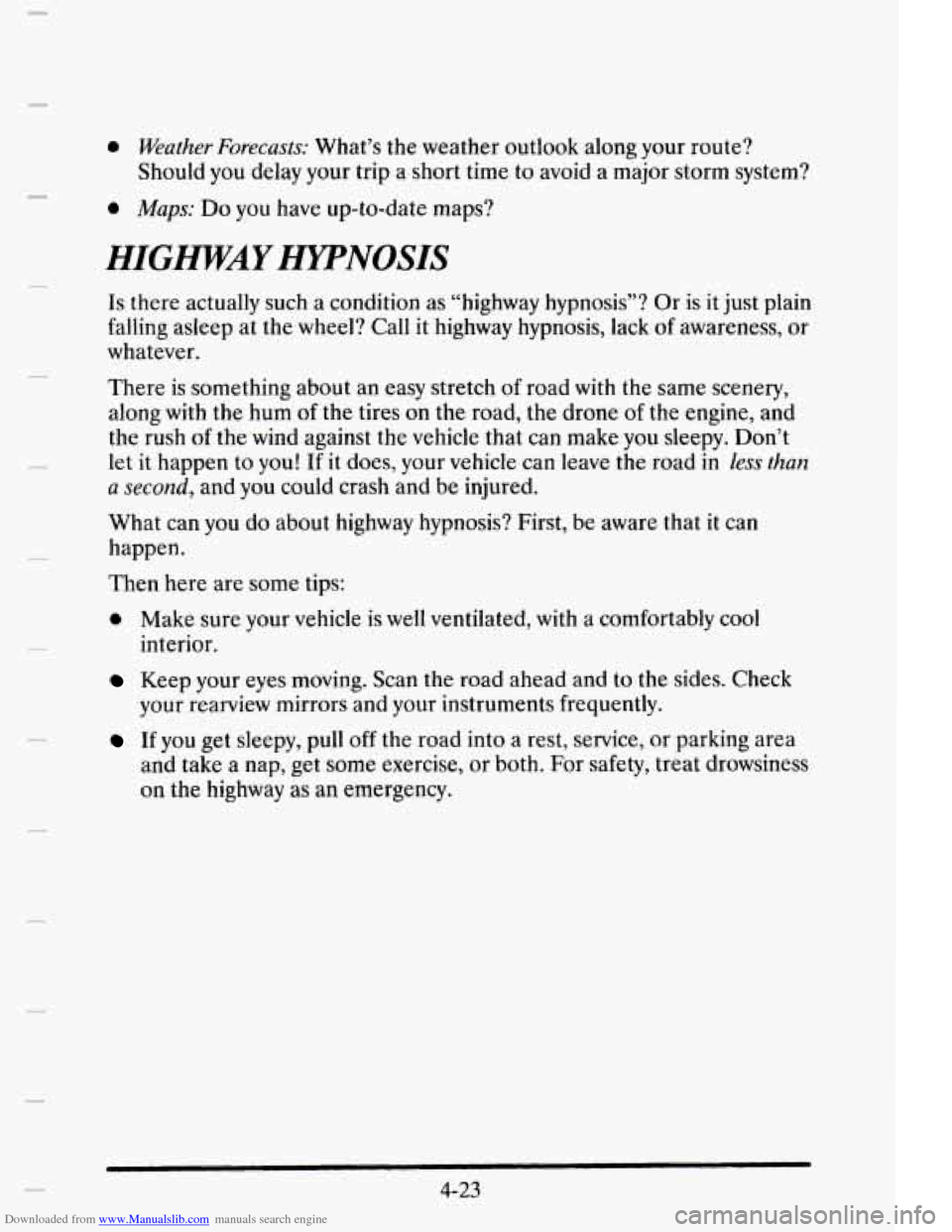
Downloaded from www.Manualslib.com manuals search engine 0 Weather Forecasts: What’s the weather outlook along your route?
0 Maps: Do you have up-to-date maps?
Should you delay your
trip a short time
to avoid a major storm system?
HIGWAY HITNOSIS
Is there actually such a condition as “highway hypnosis”? Or is it just plain
falling asleep at the wheel? Call it highway hypnosis, lack of awareness, or
whatever.
c
There is something about an easy stretch of road with the same scenery,
along with the
hum of the tires on the road, the drone of the engine, and
the rush
of the wind against the vehicle that can make you sleepy. Don’t
let it happen to you! If it does, your vehicle can leave the road in less than
a second, and you could crash and be injured.
What can
you do about highway hypnosis? First, be aware that it can
happen.
Then here are some tips:
0 Make sure your vehicle is well ventilated, with a comfortably cool
interior.
Keep your eyes moving. Scan the road ahead and to the sides. Check
your rearview mirrors
and your instruments frequently.
If you get sleepy, pull off the road into a rest, service, or parking area
and take a nap, get some exercise, or both. For safety, treat drowsiness
on the highway as an emergency.
4-23
Page 211 of 395
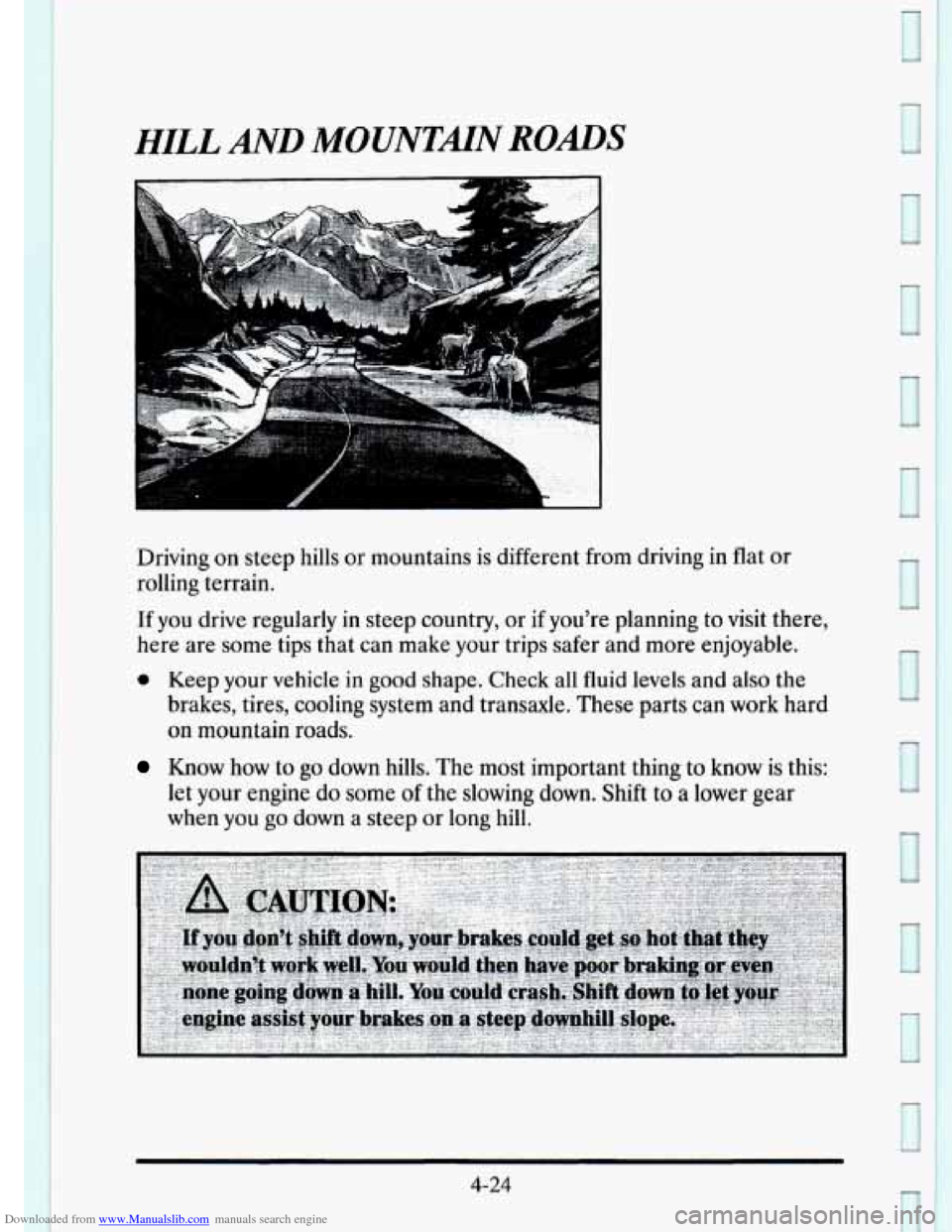
Downloaded from www.Manualslib.com manuals search engine HILL AND MOUNTMN ROADS
Driving on steep hills or mountains is different from driving in flat or
rolling terrain.
If you drive regularly in steep country, or if you’re planning to visit there,
here are some tips that can make your trips safer and more enjoyable.
0 Keep your vehicle in good shape. Check all fluid levels and also the
brakes, tires, cooling system and transaxle. These parts can work hard
on mountain roads.
Know how to go down hills. The most important thing to know is this:
let your engine do some
of the slowing down. Shift to a lower gear
when you
go down a steep or long hill.
4-24
Page 214 of 395
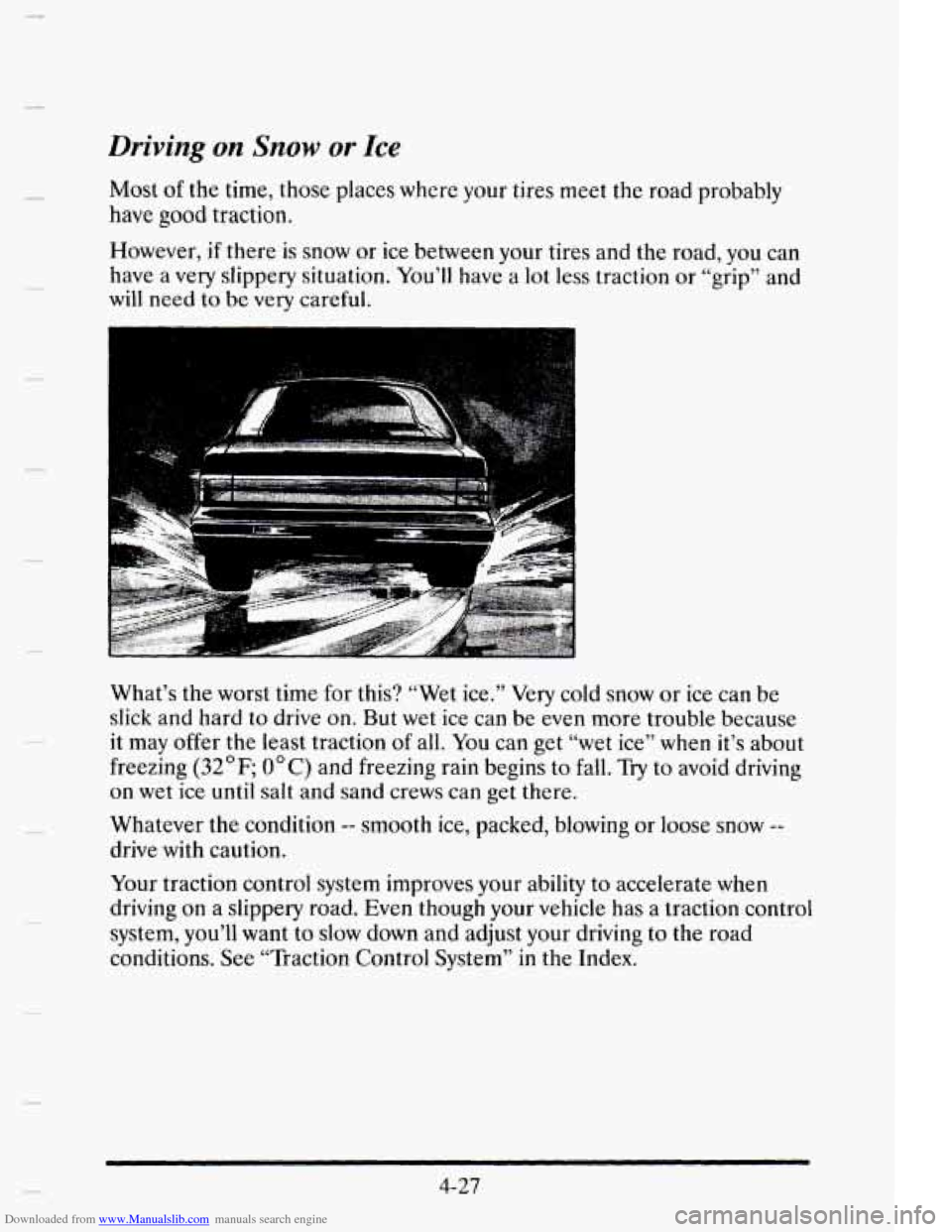
Downloaded from www.Manualslib.com manuals search engine Driving on Snow or Ice
Most of the time, those places where your tires meet the road probably
have good traction.
However,
if there is snow or ice between your tires and the road, you can
have a
very slippery situation. You’ll have a lot less traction or “grip” and
will need to be very careful.
. . ..
What’s the worst time for this? “Wet ice.” Very cold sn ow or ice can be
slick and hard
to drive on. But wet ice can be even more trouble because
it may offer the least traction of all. You can get “wet ice” when it’s about
freezing
(32°F; 0°C) and freezing rain begins to fall. Try to avoid driving
on
wet ice until salt and sand crews can get there.
Whatever
the condition -- smooth ice, packed, blowing or loose snow --
drive with caution.
Your traction control system improves your ability
to accelerate when
driving on
a slippery road. Even though your vehicle has a traction control
system, you’ll want
to slow down and adjust your driving to the road
conditions. See “Traction Control System”
in the Index.
4-27
Page 217 of 395
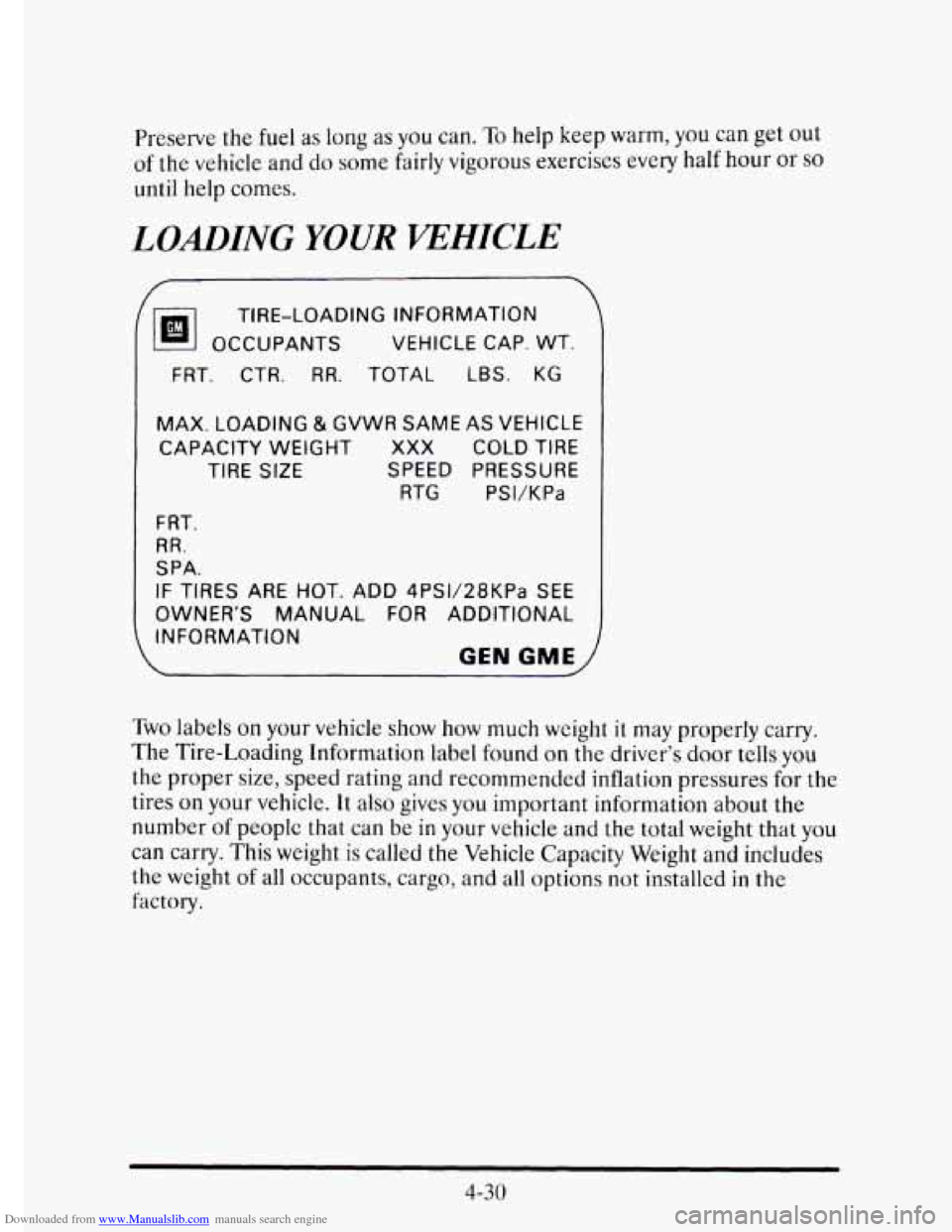
Downloaded from www.Manualslib.com manuals search engine Preserve the fuel as long as you can. To help keep warm, you can get out
of the vehicle and do some fairly vigorous exercises every half hour or
SO
until help comes.
LOmING YOUR VEHICLE
~~
( TIRE-LOADING INFORMATION
OCCUPANTS VEHICLE CAP.
WT.
FRT. CTR. RR. TOTAL LBS. KG
MAX. LOADING
& GVWR SAME AS VEHICLE
CAPACITY WEIGHT XXX
COLD TIRE
TIRE SIZE SPEED PRESSURE
RTG PSVKPa
F
RT.
RR.
SPA.
IF TIRES ARE HOT. ADD 4PSV28KPa SEE
OWNER’S MANUAL FOR ADDITIONAL
INFORMATION
-_ - - - GEN GME,
Two labels on your vehicle show how much weight it may properly carry.
The Tire-Loading Information label found
on the driver’s door tells you
the proper size, speed rating and recommended inflation pressures for the
tires
on your vehicle. It also gives you important information about the
number
of peoplc that can be in your vehicle and the total weight that you
can carry. This weight
is called the Vehicle Capacity Weight and includes
the weight
of all occupants, cargo, and all options not installed in the
factory.
4-30
Page 220 of 395

Downloaded from www.Manualslib.com manuals search engine NOTICE:
Pulling a trailer improperly can damage your vehicle and result
in costly repairs not covered by your warranty. To pull a trailer
correctly, follow the advice in this part, and see your Cadillac
dealer for important information about towing a trailer with
your vehicle.
Your vehicle can tow a trailer if it is equipped with the Northstar 4.6L
engine and proper trailer towing equipment. To identify what the vehicle
trailering capacity
is for your vehicle, you should read the information in
“Weight of the Trailer” that appears later in this section. But trailering is
different than just driving your vehicle by itself. Trailering means changes
in handling, durability, and fuel economy. Successful, safe trailering takes
correct equipment, and it has to be used properly.
That’s the reason for this part. In it are many time-tested, important
trailering tips and safety rules. Many
of these are important for your
safety and that
of your passengers. So please read this section carefully
before you pull
a trailer.
Load-pulling components such as the engine, transaxle, wheel assemblies,
and tires are forced to work harder against the drag
of the added weight.
The engine is required
to operate at relatively higher speeds and under
greater loads, generating extra heat. What’s more, the trailer adds
considerably
to wind resistance, increasing the pulling requirements.
If You Do Decide To Pull A nailer
If you do, here are some important points.
e There are many different laws, including speed limit restrictions,
having to do with trailering. Make sure your rig will
be legal, not only
where you live but
also where you’ll be driving. A good source for this
information can be state or provincial police.
Consider using a sway control.
4-33
Page 223 of 395
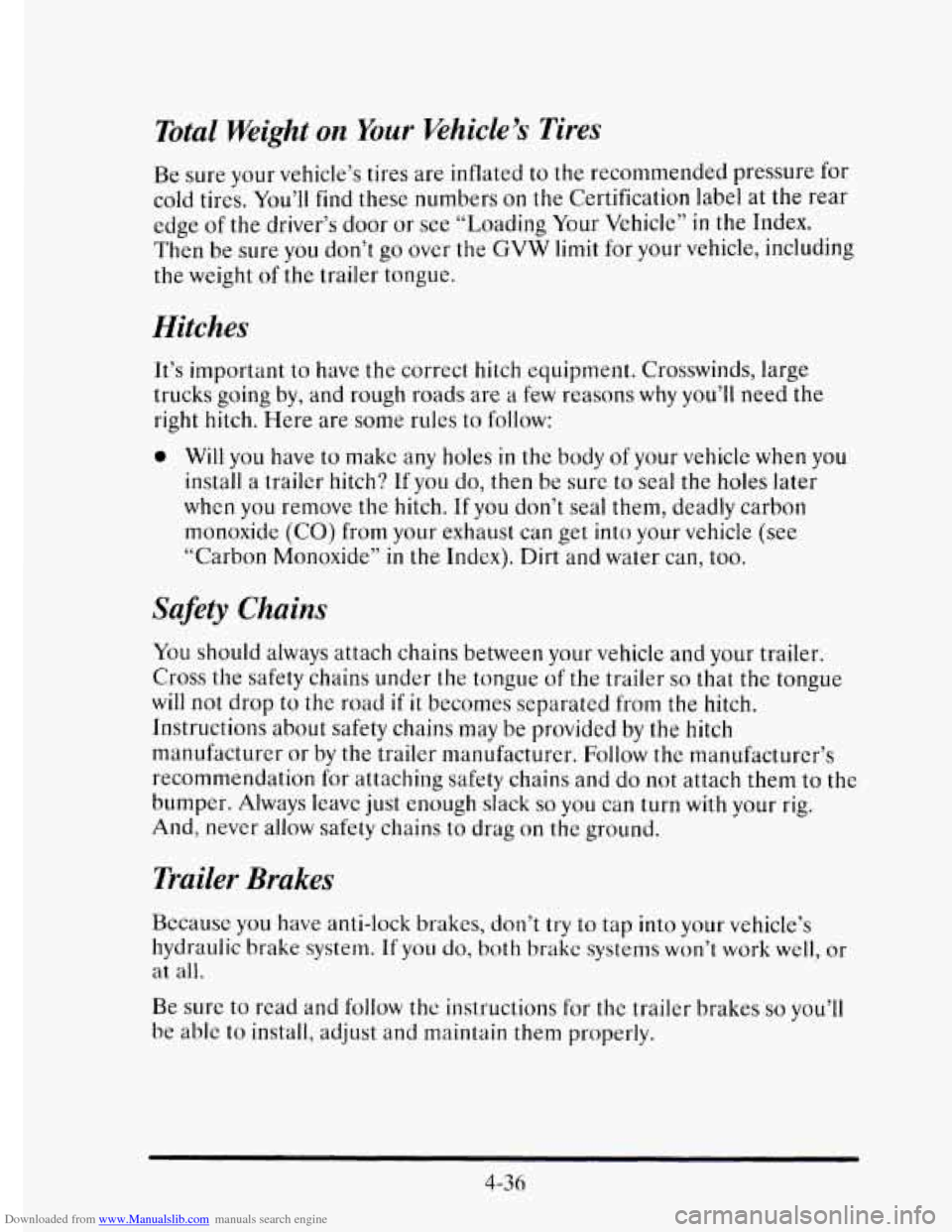
Downloaded from www.Manualslib.com manuals search engine Total Weight on Your khicle’s Tires
Be sure your vehicle’s tires are inflated to the recommended pressure for
cold tires. You’ll find these numbers on the Certification label
at the rear
edge
of the driver’s door or see “Loading Your Vehicle” in the Index.
Then be sure
you don’t go over the GVW limit for your vehicle, including
the weight of the trailer tongue.
Hitches
It’s important to have the correct hitch equipment. Crosswinds, large
trucks going by, and rough roads are a
few reasons why you’ll need the
right hitch. Here are some rules
to follow:
0 Will you have to makc any holes in the body of your vehicle when you
install a trailer hitch?
if you do, then be sure to seal the holes later
whcn
you remove the hitch. If you don’t seal them, deadly carbon
monoxide
(CO) from your exhaust can get into your vehicle (see
“Carbon Monoxide”
in the Index). Dirt and water can, too.
Safety Chains
You should always attach chains between your vehicle and your trailer.
Cross the safety chains under
the tongue of the trailer so that the tongue
will not drop to thc road if it becomes separated from the hitch.
Instructions about safety chains may be provided by the hitch
manufacturer or by the trailer manufacturer. Follow the manufacturcr’s
recommendation for attaching safety chains and do not attach them to the
bumper. Always leave
just enough slack so you can turn with your rig.
And, never allow safety chains to drag on the ground.
Trailer Brakes
Because you have anti-lock brakes, don’t try to tap into your vehicle’s
hydraulic brake system.
If you do, both brake systems won’t work well, or
at all.
Be sure to read and follow thc instructions for the trailer brakes so you’ll
be able to install, adjust and maintain them properly.
4-36
Page 224 of 395

Downloaded from www.Manualslib.com manuals search engine Driving with a Trailer
n Towing a trailer requires a certain amount of experience. Before setting
out for the open road, you’ll want to get to
know your rig. Acquaint
yourself with the feel
of handling and braking with the added weight of
the trailer. And always keep in mind that the vehicle you are driving is
now a good deal longer and not nearly as responsive as your vehicle is by
itself.
Before you start, check the trailer hitch and platform (and attachments),
safety chains, electrical connector, lamps, tires and mirror adjustment. If
the trailer has electric brakes, start your vehicle and trailer moving and
then apply the trailer brake controller by hand to be sure the brakes are
working. This lets you check your electrical connection at the same time.
. During your trip, check occasionally to be sure that the load is secure, and
that the lights and any trailer brakes are still working.
Following Distance
Stay at least twice as far behind the vehicle ahead as you would when
driving your vehicle without a trailer. This can help you avoid situations
that require heavy braking and sudden turns.
Passing
You’ll need more passing distance up ahead when you’re towing a trailer.
And, because you’re a good deal longer, you’ll need to
go much farther
beyond the passed vehicle before you can return to your lane.
Backing Up
Hold the bottom of the steering wheel with one hand. Then, to move the
trailer to the left, just move that hand to the left.
To move the trailer to
the right, move your hand to the right. Always back up slowly and,
if
possible, have someone guide you.
4-37
Page 236 of 395

Downloaded from www.Manualslib.com manuals search engine n
c
TOWING YOUR VEHICLE
Try to have a GM dealer or a professional towing service tow your
Cadillac. The usual towing equipment is:
W
W
W
W W
Sling Type
Wheel Lift
Car Carrier
If your vehicle has been changed or modified since it was factory-new by
adding aftermarket items Iike fog lamps, aero skirting
or special tires and
wheels, these instructions and illustrations may not be correct.
Before you do anything, turn on the hazard warning flashers.
When you call, tell the towing service:
That your vehicle cannot be towed from the front or rear with
That your vehicle has front-wheel drive.
0 The make, model and year of your vehicle.
0 Whether you can still move the shift lever.
0 If there was an accident, what was damaged.
sling-type
equipment.
5-9